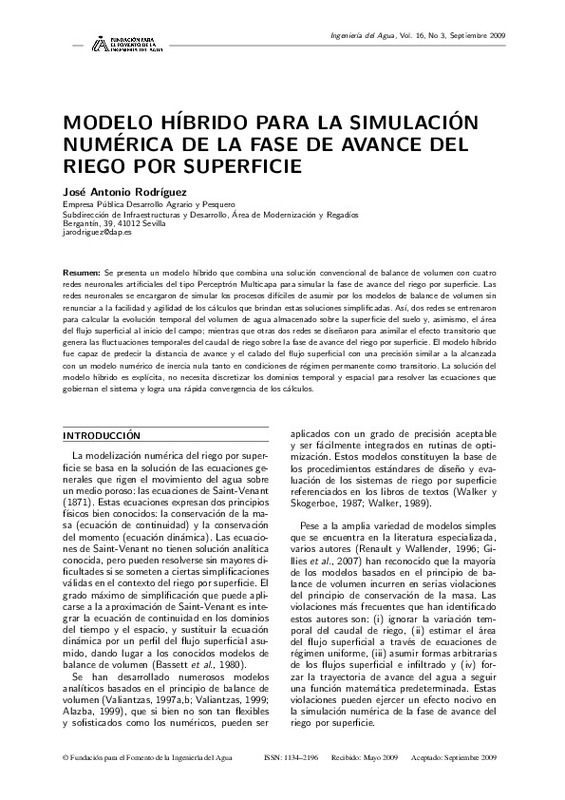Al-Azba, A.A., (1999). Explicit volume balance model solution. Journal of Irrigation and Drainage Engineering, ASCE, 125(5), 273-279.
Bassett, D.L., Frangmeier, D.D. y Strelkoff, T., (1980). Hydraulics of surface irrigation systems. En: Design and operation of farm irrigation systems. ASAE Monograph No.3, St. Joseph, Michigan, 829 pp.
Bautista, E., Clemmens, A.J., Strelkoff, T. y Schlegel, J.L., (2009). Modern analysis of surface irrigation systems with WinSRFR. Agricultural Water Management, 96, 1146-1154.
[+]
Al-Azba, A.A., (1999). Explicit volume balance model solution. Journal of Irrigation and Drainage Engineering, ASCE, 125(5), 273-279.
Bassett, D.L., Frangmeier, D.D. y Strelkoff, T., (1980). Hydraulics of surface irrigation systems. En: Design and operation of farm irrigation systems. ASAE Monograph No.3, St. Joseph, Michigan, 829 pp.
Bautista, E., Clemmens, A.J., Strelkoff, T. y Schlegel, J.L., (2009). Modern analysis of surface irrigation systems with WinSRFR. Agricultural Water Management, 96, 1146-1154.
Bishop, M., (1995). Neural Networks for Pattern Recognition. Oxford University Press.
Brown, M.B. y Forsythe, A.B., (1974). Robust Tests for Equality of Variances. Journal of the American Statistical Association, 69: 364-367.
Dibike, Y.B., (2002). Developing generic hydrodynamic models using artificial neural networks. Journal of Hydraulic Research, 40(2), 183-190.
Gillies, M.H., Smith, R.J. y Raine, S.R., (2007). Accounting for temporal inflow variation in the inverse solution for infiltration in surface irrigation. Irrigation Science, 25(2): 87-97.
Hagan, M.T. y Menhaj, M.B., (1994). Training feedforward networks with the Marquardt algorithm. IEEE Trans. Neural Net., 5, 989-993.
Katopodes, N.D. y Strelkoff, T., (1977). Dimensionless solutions of border-irrigation advance. Journal of Irrigation and Drainage Engineering, ASCE, 103(4), 401-417.
Kleijnen, J.P., Bettonvil, B., y Van Groenendall, W., (1998). Validation of trace-driven simulation models: a novel regression test. Management Science, 44, 812-819.
Kolmogoroff, A.N., (1933). Sulla determinazione empirica di una legge di distribuzione. Giornale dell'Istituto Italiano degli Attuari, 4, 83-91.
Kostiakov, A.N., (1932). On the dynamics of coefficient of water-percolation in soils and the necessity of studying it from a dynamic point of view for purposes of amelioration. Trans. Com. Int. Soc. Soil Sci. 6th, Mosc ́u, Part A, 267-272.
Mann, H.B. y Whitney, D.R., (1947). On a test of whether one of two random variables is stochastically larger than the other. Annals of Mathematical Statistics, 18, 50-60.
Renault, D. y Wallender, W.W., (1996). Initial-inflow variation impacts on furrow irrigation evaluation. Journal of Irrigation and Drainage Engineering, ASCE, 122(1), 7-14.
Rodr ́ıguez, J.A. y Martos, J.C., (2009). SIPAR_ID: Freeware for surface irrigation parameter identification. Environ. Model. Softw. Art ́ıculo en imprenta.
Saint-Venant, A.J.C., (1871). Théorie du mouvement non permanent des eaux, avec application aux des rivères et a l'introduction des marées dans eut lits. Comptes rendus des séances de l'Académies Sciences, 73, 147-154.
Smirnov, N., (1933). Estimate of deviation between empirical distribution functions in two independent samples. Moscow University Mathematics Bulletin, 2, 3-16.
Smith, M., (1993). Neural networks for statistical modeling. Van Nostrand Reinhold, New York.
Tedeschi, L.O., (2006). Assessment of the adequacy of mathematical models. Agricultural Systems, 89, 225-247.
Valiantzas, J.D., (1997a). Surface irrigation advance equation: Variation of subsurface shape factor. Journal of Irrigation and Drainage Engineering, ASCE, 123(4), 300-306.
Valiantzas, J.D., (1997b). Volume balance irrigation advance equation: Variation of surface shape factor. Journal of Irrigation and Drainage Engineering, ASCE, 123(4), 307-312.
Valiantzas, J.D., (1999). Explicit time of advance formula for furrow design. Journal of Irrigation and Drainage Engineering, ASCE, 125(1), 19-25.
Walker, W.R., (1989). Guidelines for designing and evaluating surface irrigation system. FAO Irrigation and Drainage Paper No. 45, Rome, 137pp.
Walker, W.R. y Skogerboe, G.V., (1987). Surface irrigation: Theory and Practice. Prentice-Hall, Englewood Cliffs, New Jersey, 386pp.
Wilcoxon, F., (1945). Individual comparisons by ranking methods. Biometrics Bulletin, 1, 80-83.
Wolpert, D.H., (1996a). The lack of a priori distinctions between learning algorithms. Neural Computation, 8, 1341-1390.
Wolpert, D.H., (1996b). The existence of a priori distinctions between learning algorithms. Neural Computation, 8, 1391-1420.
[-]








